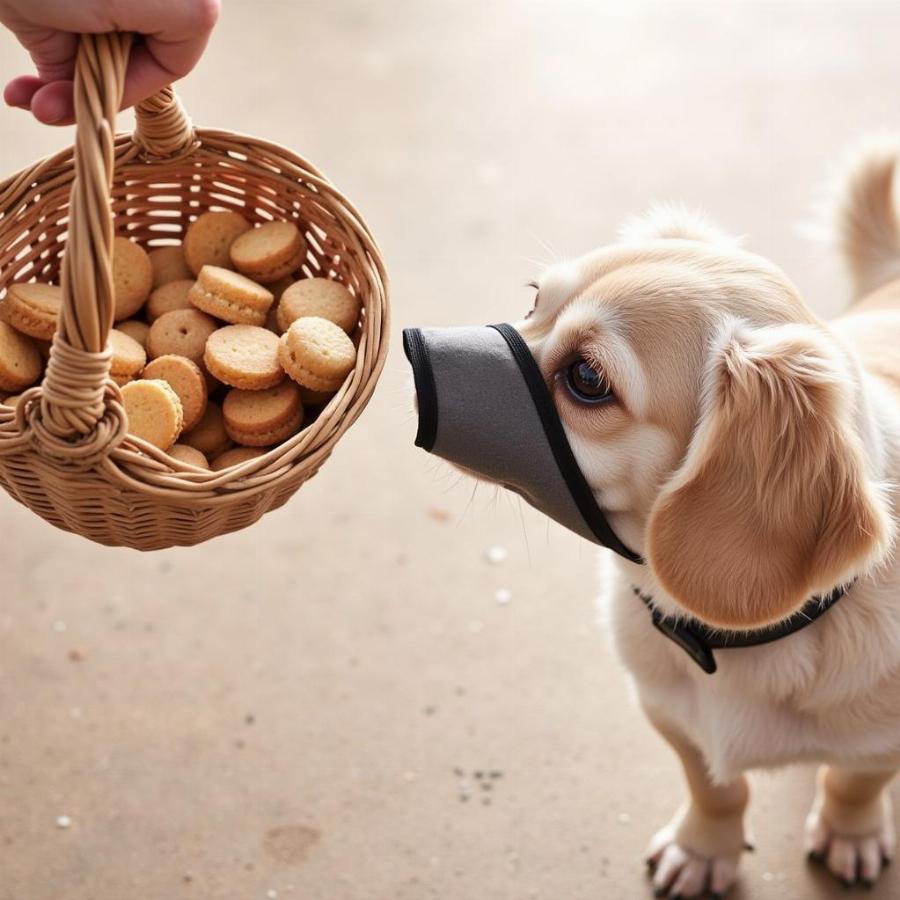Small dog muzzles can be a valuable tool for various situations, from vet visits and grooming appointments to managing reactivity and preventing unwanted behaviors. While the idea of a muzzle might seem intimidating, understanding their purpose, types, and proper usage can transform them into a helpful accessory for both you and your small breed companion. This guide will delve into everything you need to know about small dog muzzles, helping you choose the right one and ensure a comfortable and positive experience for your furry friend.
Choosing the Right Muzzle for Your Small Dog
Selecting the appropriate muzzle for your small dog depends on various factors, including the dog’s breed, size, and the intended purpose. There are several types of muzzles available, each with its own pros and cons.
Types of Small Dog Muzzles
-
Basket Muzzles: These are the most common and generally recommended type. Basket muzzles allow for panting, drinking, and even taking treats, ensuring your dog remains comfortable. They come in various materials like plastic, metal, and biothane. For small breeds, look for lightweight and well-ventilated options.
-
Soft Muzzles (Fabric or Mesh): While these are lightweight and inexpensive, they restrict panting and are not suitable for extended periods or warm weather. They’re best used for very short durations, such as during a quick vet visit.
-
Short Snout Muzzles: These are specifically designed for brachycephalic breeds (short-nosed dogs) like Pugs or French Bulldogs. They provide the necessary ventilation while still serving their purpose.
-
Grooming Muzzles: These are often loop-style muzzles, designed to prevent biting during grooming procedures. They should only be used under close supervision.
Sizing and Fitting
Proper fit is crucial for your dog’s comfort and safety. Measure your dog’s snout circumference and length according to the manufacturer’s instructions. A muzzle that is too tight can restrict breathing, while one that is too loose can easily be slipped off.
Why Use a Muzzle on a Small Dog?
Many owners perceive muzzles negatively, associating them with aggression. However, small dog muzzles serve numerous beneficial purposes beyond managing biting.
Veterinary Visits and Grooming
Muzzles provide safety for veterinary staff and groomers, especially when dealing with anxious or fearful dogs. Even the sweetest dog might nip when in pain or discomfort.
Preventing Scavenging
Small dogs are notorious for scavenging, which can lead to ingestion of harmful substances. A muzzle can effectively prevent them from picking up things off the ground.
Managing Reactivity
For dogs exhibiting reactivity towards other dogs or people, a muzzle can provide an extra layer of safety during training and socialization. muzzle for small dogs offers more information on this topic.
Introducing a Muzzle to Your Small Dog
Introducing a muzzle should be a gradual and positive process. Forcefully putting a muzzle on a dog can create negative associations and make future use difficult.
 Introducing a muzzle to a small dog
Introducing a muzzle to a small dog
Positive Reinforcement
Associate the muzzle with positive experiences, such as treats and praise. Start by letting your dog sniff and investigate the muzzle. Gradually progress to short periods of wearing the muzzle, rewarding your dog throughout the process. soft muzzle for dogs might be a good starting point for some dogs.
Common Concerns About Small Dog Muzzles
Can my dog breathe and pant in a muzzle?
With a properly fitted basket muzzle, your dog should be able to pant, drink, and even take treats. metal dog muzzle are often chosen for their durability.
Will a muzzle make my dog look aggressive?
While some people might initially associate muzzles with aggression, educating others about their various uses can help change perceptions. Focus on the positive benefits and your dog’s well-being.
Conclusion
Small dog muzzles are a valuable tool when used responsibly and humanely. They offer a safe and effective way to manage various situations, ensuring the well-being of both your dog and those around them. By understanding the different types of muzzles, proper fitting techniques, and positive introduction methods, you can make the experience comfortable and stress-free for your small breed companion. Remember to choose a muzzle that allows for panting and drinking, and prioritize your dog’s comfort above all else. dog muzzle short snout is a helpful resource for owners of brachycephalic breeds.
FAQ
-
How do I measure my dog for a muzzle? Measure the circumference of their snout and the length from the tip of their nose to just below their eyes.
-
What type of muzzle is best for a small dog? Basket muzzles are generally recommended for their ventilation and comfort.
-
Can my dog drink water with a muzzle on? Yes, they should be able to drink with a properly fitted basket muzzle.
-
How long can my dog wear a muzzle? This depends on the situation and the type of muzzle. Basket muzzles can be worn for extended periods, while soft muzzles should only be used for short durations.
-
Are muzzles cruel? No, when used correctly, muzzles are not cruel. They provide safety and can prevent harmful behaviors.
-
My dog hates the muzzle, what should I do? Try a different type or size. Introduce the muzzle slowly with positive reinforcement.
-
Can muzzles be used for training? Yes, they can be a helpful tool in managing reactivity and preventing unwanted behaviors during training.
Beaut Dogs is your one-stop resource for all things related to dog care, offering expert advice and guidance on various breeds and their unique needs. From choosing the right food to understanding training techniques, Beaut Dogs provides valuable insights to help you provide the best care for your canine companion. For personalized assistance and detailed information, please contact us via Email at [email protected]. We are here to support you and your furry friend.